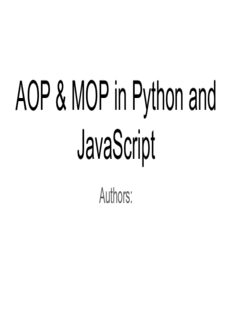
AOP & MOP in Python and JavaScript PDF
Preview AOP & MOP in Python and JavaScript
AOP & MOP in Python and JavaScript Authors: Python MOP Every dataset should come with a domain for each attribute. The validation process makes sure that the data falls between these ranges to be used smoothly further in the application. Python MOP Cleaning the data before validating a certain dataset has the role to delete only the invalid rows that contain errors. With this approach we avoid losing a majority of good rows because of just a few invalid ones. Python MOP The cleaning function drops the rows that contain different values than expected and the validation function determines if the dataset can be used or not. Python MOP The “spec_validate_then_send” function verifies not to forward a CSV if it was not validated before. Also, if there was an upload of a new CSV, it also has to be verified before forwarding it. Python MOP The “simple_specification” function verifies if function “valid_csv” returns bool type. The “more_specifications2” function verifies if after each call of the function “simulate_interraction”, it is called the “decrypt” function. Python MOP Monitoring makes sure to start the cleaning function each time the validation takes place in case it was omitted. This way we make sure to keep good data that without being cleaned would be discarded in the validation process. JavaScript AOP ● Using the help of kaop-ts library, we can import AOP support such as afterMethod and beforeMethod and create custom annotation to use in our production code. ● In this example, our target is to create two annotations that are used to log when the execution of the program enters and exits from a functions code block. The enter arguments and the exit result are also provided in our logs. Javascript AOP Basic annotations are useful, but their power comes export function LogEnter(filename) { from customization (parametrization for decorators). return beforeMethod(meta => { const message = createEnterMethodMessage(meta); In kaop-ts, this can be achieved by using currying, logMessage(filename, wrapInDate(message), in our specific case, logging, by wrapping our initial onError(filename, meta)); decorator inside another generator method. }); } On the left, an example of parameterization is provided. The method we wish to log is decorated export function LogExit(filename) { as follows: return afterMethod(meta => { @LogEnter('/tmp/ID3.log') const message = createExitMethodMessage(meta); @LogExit('/tmp/ID3.log') logMessage(filename, wrapInDate(message), build_id3_node(attributes, label, possible_values, onError(filename, meta)); decisions) { }); ... } } JavaScript AOP ● Still, annotations functionality in JavaScript are in testing so developers must pay attention if they really need them and must make some configuration to enable annotations ● The configuration file is named .babelrc which should be placed in the root of the project and could look like in the image from the right side of the slide ● Babel requirements should be installed as well
Description: